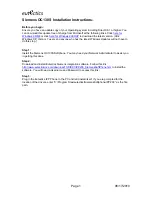
24 K
aspersky Internet Security 6.0
2.2. The elements of Kaspersky
Internet Security Defense
Kaspersky Internet Security protection is designed with the sources of threats in
mind. In other words, a separate program component deals with each threat,
monitoring it and taking the necessary action to prevent malicious effects of that
threat on the user's data. This setup makes the system flexible, with easy
configuration options for all of the components that fit the needs of a specific user
or business as a whole.
Kaspersky Internet Security includes:
•
Protection Components (see 2.2.1 on pg. 24) that comprehensively
defend all channels of data transmission and exchange on your computer.
•
Virus Scan Tasks (see 2.2.2 on pg. 26) that virus-check the computer’s
memory and file system, as individual files, folders, disks, or regions.
•
Support Tools (see 2.2.3 on pg. 27) that provide support for the program
and extend its functionality.
2.2.1. Protection components
These protection components defend your computer in real time:
File Anti-Virus
A file system can contain viruses and other dangerous programs.
Malicious programs can remain inactive in your file system for years after
one day being copied from a floppy disk or from the Internet, without
showing themselves at all. But you need only act upon the infected file,
and the virus is instantly activated.
File Anti-virus
is the component that monitors your computer’s file system.
It scans all files that can be opened, executed or saved on your computer
and all connected disk drives. The program intercepts every attempt to
access a file and scans the file for known viruses, only making the file
available to be used further if it is not infected or is successfully
disinfected by File Anti-Virus. If a file cannot be disinfected for any
reason, it will be deleted, with a copy of the file either saved in Backup
(see 17.2 on pg. 223), or moved to Quarantine (see 17.1 on pg. 219).
















































